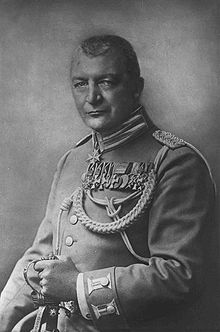Draft:Battle of Okahandja
 | Review waiting, please be patient.
This may take 3 months or more, since drafts are reviewed in no specific order. There are 2,565 pending submissions waiting for review.
Where to get help
How to improve a draft
You can also browse Wikipedia:Featured articles and Wikipedia:Good articles to find examples of Wikipedia's best writing on topics similar to your proposed article. Improving your odds of a speedy review To improve your odds of a faster review, tag your draft with relevant WikiProject tags using the button below. This will let reviewers know a new draft has been submitted in their area of interest. For instance, if you wrote about a female astronomer, you would want to add the Biography, Astronomy, and Women scientists tags. Editor resources
Reviewer tools
|
| The Battle of Okahandja | |||||||
|---|---|---|---|---|---|---|---|
| Part of Herero Wars | |||||||
| |||||||
| Belligerents | |||||||
|
| Herero | ||||||
| Commanders and leaders | |||||||
|
| Unknown | ||||||
| Strength | |||||||
| 145 | Unknown | ||||||
The Battle of Okahandja took place on the January 28th, 1904 in German South West Africa (modern day Namibia). The battle was fought between the German Imperial Forces (Schutztruppe) and the Herero forces and played an important strategic role for the German advance. [1]
Armies[edit]

The German Imperial Forces, more specifically the 2nd Feldkompagnie, were led by Captain Viktor Franke and consisted of 6 officers, 2 doctors, 27 gunmen and 110 infantry troops. The Germans carried heavy weaponry including a 8 cm Kanone C/73 (field gun) and a unspecified mountain gun.
There is no estimates on the size of the Herero forces in the battle but it is described as being "strong forces". [1]
Strategic relevance[edit]

The small town of Okahandja had a central significane in the presence of a rail station connected to the colonial rail line. The colonial rail line ran from Swakopmund to Windhoek and the resupply and reinforcement of Windhoek were dependent on this exact rail line.
Battle terrain[edit]
The terrain surrounding Okahandja was a challenging aspect for the German advancing troops, having to attack uphill into entrenched mountain terrain. While the Okahandja Rail Station were situatied in flat terrain, the Herero forces had fortified themselves to the east up the mountain of Kaiser Wilhelm Berg (1.997m). The German advances and securing of the Okahandja Rail Station required tackling the unfavourable terrain up Kaiser Wilhelm Berg to eliminate Herero riflemen. [1]

The Battle[edit]
The battle was fairly long lasting about 6 hours. Despite the long battle German troops had fairly little resistance in their advances up Kaiser Wilhelm Berg, probably due to the artillery fire from the 8 cm Kanone C/73 and the mountain gun. In addition to the superior weaponry, the German troops had another advantage in the frequent occurrence of "dead ground", which refer to positions in which the defending force has no visual of the attacking force.
Despite the challenges set by the terrain, the Germain superiority in weaponry and the occruence of "dead ground" made the German victory inevitable. The German troops did not suffer large losses with only 3 wounded. The Herero troops suffered fairly heavy losses from artillery fire but the main part of the troops fled when realizing the inferior balance of power between the two forces.[1]
References[edit]
- ^ a b c d "THE BATTLE OF OKAHANDJA | Hererowars". hererowars.com. Retrieved 2024-02-16.
